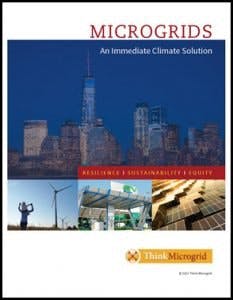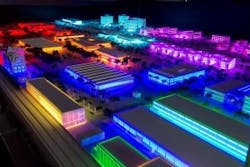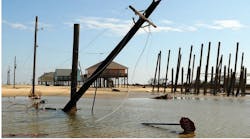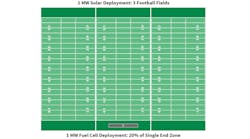In the fifth and final article of this special report series brought to you by Microgrid Knowledge and Think Microgrid, we’ll look at how to redesign the electrical system with the future climate in mind. We’ll also discuss how to capture microgrid benefits in climate change strategies and infrastructure plans.
Read the entire vision paper.
Redesign the electrical system with the future climate in mind
The Biden administration has set a goal to achieve 100% carbon– and pollution-free electricity by 2035 and achieve net-zero emissions economywide by no later than 2050. A report by the Sustainable Development Solutions Network, called the Zero Carbon Action Plan, found that the US will need to nearly triple its renewable generation capacity to achieve this, adding 100 gigawatts every year between now and 2050, mostly from wind and solar. To put the scope of that undertaking in perspective, the US added 29 gigawatts of renewables in 2020.
According to an analysis published by Wood Mackenzie, the grid can reach 25% wind and solar penetration with relative ease. But “beyond that point, operational and cost complexities progressively multiply, in large part due to the intermittent nature of renewables.” No grid, the report said, has yet operated with more than 30% renewable energy.
One way to overcome renewable intermittency is by tapping into distributed energy resources, such as microgrids, that can quickly respond and provide service to the grid to keep supply and demand in balance.
In their first year of service, two microgrids installed by Arizona Public Service (APS) helped restore frequency within the Western Electricity Coordinating Council, which manages grid reliability for the 14 Western states, Alberta and British Columbia, and the northern portion of Baja California, Mexico.
In doing so, APS demonstrated how microgrids can do more than keep the power flowing to connected buildings during an outage; they can offer value to the broader electric grid as well. Grid frequency can go out of balance when a generator suddenly trips offline. For example, an 850-MW hydroelectricity facility could suddenly stop producing power in the Pacific Northwest, sending a ripple effect through the Western states, like a rock dropped in a pond.
Various generators respond to restore balance. Speed is of the essence. That’s where the APS diesel-based microgrids excel. Acting together as a single virtual power plant, the two microgrids respond far more quickly than conventional turbines. The microgrids see a deviation, start up and energize into the grid, as well as support the critical load, in under 20 seconds. In contrast, a conventional turbine could take up to an hour to respond if it is not already running or 10 minutes if it is spinning and ready to go when needed.
The response comes thanks to an APS-designed microgrid controller — what is known as the brain of a microgrid — which monitors the grid at all times and signals to the virtual power plant that the grid needs help with frequency.
Microgrids not only help the grid manage renewables, but it also increasingly incorporates them as their primary energy sources, coupling them with energy storage and backup generators.
In Ontario, California, Kaiser Permanente is developing a microgrid designed to demonstrate that hospitals can incorporate renewable energy and move away from diesel generators. The hospital microgrid will also feature a fuel cell and a demonstration virtual power plant — with microgrids located in up to three different utility territories. The project includes solar, a Bloom Energy fuel cell and battery storage.
Kodiak Island, a remote community in the Gulf of Alaska with about 15,000 people, receives its power solely from a microgrid that is run on 99% renewable energy and operated by an electric cooperative. Kodiak is the US’ third most productive fishing port and home to its largest Coast Guard base. Unconnected to any other grid, the island requires 28 MW, which it derives from a combination of wind power, hydroelectricity, batteries and flywheels. Once heavily reliant on diesel generators, the electric cooperative now uses the generators only as backup for its hydroelectric plant when it is undergoing maintenance. Use of the microgrid has not only brought cleaner power to Kodiak but has also lowered electricity rates on the island.
A school district in Santa Barbara, California, is installing 14 solar facilities, including six solar microgrids, along with battery storage. The solar panels will produce about 90% of the district’s power needs and are expected to save about $7.8 million in electricity costs over 28 years. It also expects to reap $6.5 million in resiliency costs that it would have had to spend on backup generators.
The school district may also be able to earn money by participating in wholesale markets run by the California Independent System Operator. The project meets the school district’s sustainability goals by avoiding greenhouse gas emissions while providing community shelters during emergencies.
When disaster strikes a community, it is often the disenfranchised that are hardest hit. Homeless families or those without transportation, for example, cannot easily evacuate during hurricanes, leaving them to suffer the worst consequences of power outages and the lack of services that ensues.
The geographic region served by the microgrid can become an island of power. The neighborhood can become a place of refuge, where community members shelter, get a hot meal, buy groceries, get clean water, charge cell phones and gas up cars. Vital services — hospitals, police stations, fire departments, communications centers and wastewater treatment plants — stay up and running.
Some communities provide microgrids for public housing where residents are restricted in their ability to evacuate during an emergency. Others protect power supply to direct care providers such as homeless shelters, nursing homes and medical satellite facilities.
Microgrids also foster economic equity. With the power flowing, people are able to work and collect their paychecks. And because of their high level of efficiency, microgrids can help dampen energy costs, putting downward pressure on electricity bills. As a form of local energy, microgrids keep energy dollars in the community and support local employment.
And, last, they help bring about greater environmental equity by offering a lower emissions, more efficient alternative to fossil fuel plants that so often dominate urban settings.
Located in Bronzeville, a largely African American section of Chicago, the solar-plus-storage microgrid includes solar installations on 660 residential units in the Dearborn Homes Community.
The project is a partnership between Exelon subsidiary Commonwealth Edison (ComEd), developer VLV Development Solutions and the Chicago Housing Authority. For VLV Development, which specializes in sustainable projects, the effort is the first in what the company hopes will be a series of low-income solar housing projects linked to microgrids. In fact, the company’s goal is to develop 50 MW of solar-plus-storage for at-risk residents, or one microgrid in each of the 50 Chicago wards, according to Van Vincent, president and CEO of VLV Development.
“Often we find with the more advanced technologies, the benefits go to more affluent communities; they don’t reach low-income communities,” said Vincent. These communities are also more vulnerable to being stranded or isolated during power outages, he said.
VLV Development is delivering a portion of the solar to the Chicago Housing Authority at a cost that will yield about $1 million in savings over 15 years.
Under development by ComEd, with Siemens and Enchanted Rock acting as vendors, the Bronzeville microgrid covers the area with about 7 MW of load, and it includes more than 1,000 mainly residential and small commercial customers who typically can’t afford systems to provide heightened grid resiliency. The Chicago Police and Fire Departments’ headquarters are among the critical infrastructure within the microgrid.
The project is helping to reinvigorate the Bronzeville neighborhood while providing the highest level of resiliency.
In Tampa, Florida, the Metropolitan Ministries Foundation saw how much its community suffered when the city lost power for four days during Hurricane Irma in 2017. The foundation, which offers services to 30,000 families and homeless individuals, attracted lines of people looking for hot meals. With no electricity, its workers were forced to prepare food in the dark using a mobile kitchen in the parking lot in order to feed community members and residents.
“It took us a little bit by surprise how much the people and city depend on us,” Justine Burke, the organization’s vice president of marketing, said in a statement. “Many couldn’t just evacuate or go to a hotel for a week because they could not afford it. When we showed up to work the next day, there was a huge line of people outside of our Outreach Center, waiting for us to help them.”
The ministries got by using portable generators, some borrowed. But after that experience, the organization began looking for a more permanent solution before the next disaster hit. The board of directors found the answer in a microgrid brought to them by a partnership of PowerSecure and Tampa Electric (TECO).
The microgrid was configured for Metropolitan Ministries with a single point of contact with the grid and advanced paralleling switchgear. The system includes a Tier 4 diesel engine with the ability to isolate from the grid automatically in an outage or when it is called upon by TECO for load management.
About 23 million people in the US live in food deserts, areas where stores that offer fresh and healthy food are at least a mile away. About half of this population is low income, and many are in urban areas, according to the US Department of Agriculture.
Urban agriculture is viewed as a way to counter food deserts, and microgrids are a natural companion to these facilities.
Vertical indoor farming, in particular, offers several advantages because it not only grows healthy food closer to consumers, but requires less land, water and pesticides than conventional agriculture.
However, vertical indoor farming is very energy-intensive.
To better manage their energy, Bowery Farming and Fifth Season have installed microgrids at indoor farming facilities in the Northeast US. Developed by Scale Microgrid, the projects use Schneider Electric software and control tools. Using solar, storage and natural gas generators, the projects bring significant environmental benefits and economic advantages. They sell ancillary services to the electric grid, which provides a revenue stream and helps offset microgrid costs and reduces greenhouse gas emissions.
How to capture the full benefits of microgrids in climate change strategies and infrastructure plans
Achieving the full potential of microgrids requires dedicated and deliberate action by regulators and policymakers. This is an urgent issue and speed is of the essence. Climate-enhanced disasters are already upon us, causing widespread and prolonged power outages and suffering. Too often, we see that many of these impacts were avoidable. Proposals to build microgrids in New Orleans were dismissed in favor of utility investments in transmission and large generation. When Hurricane Ida came through in August 2021, those systems failed.
There is no shortage of private capital ready to invest in microgrids and advanced energy solutions, but that requires more sensible price signals and tariffs. Unpredictable costs and arbitrary interconnection requirements hamper customer investments in microgrids, denying full achievement of cost savings. — Think Microgrid, “Microgrids: An Immediate Climate Solution“
In this regulatory environment, microgrid development is a slow and daunting task. The component technologies can be installed relatively quickly, but outdated state, federal and utility requirements add unnecessary costs and delay projects. Regulatory reform that focuses on fair value, fair access and fair rates is urgently needed. There is no shortage of private capital ready to invest in microgrids and advanced energy solutions, but that requires more sensible price signals and tariffs. Unpredictable costs and arbitrary interconnection requirements hamper customer investments in microgrids, denying full achievement of cost savings. Rectifying these issues will help cities, towns and utility planners better understand where, when and how to incorporate microgrids into their resilience and infrastructure planning.
Of particular importance are:
- Resiliency value: Identifying reasonable and accurate ways to value the energy services provided by microgrids in both critical and everyday contexts.
- Rate reform: Working to establish fair rate structures that are rooted in actual operational experience and true costs of service.
- Open access: Establishing level playing fields and sensible interconnection strategies that encourage market access.
- Policy alignment: Developing new, forward-looking mechanisms that recognize the value of a digitized grid and encourage development of microgrids as key solutions to resiliency, equity and climate challenges.
Locational value
Recognition of resiliency value: To position microgrids in the market, it’s important to define the value of their services. A key service that microgrids provide is energy resilience, a means to avoid power outages and recover from them quickly when they do occur. While resilience is embedded in utility rates, it is not compensated when it is supplied by a microgrid from a non-utility owner, such as a community, business or institution. The owner of the microgrid assumes the resiliency cost, in essence, subsidizing the local utility. How can resilience from microgrids be more accurately valued and compensated? Understanding the value of resilience will help cities and states assess resiliency needs and identify microgrid deployment opportunities.
It’s important that pricing on these nodes be clear, transparent and technology agnostic so that the least expensive asset — be it a microgrid, battery, interactive building, EV fleet or some other form of distributed energy — can be chosen to provide the service. — Think Microgrid, “Microgrids: An Immediate Climate Solution“
Recognition of locational value: During blue sky conditions, a microgrid can serve as a flexible grid asset, ready to be deployed as conditions on the grid change. The exact value of the microgrid depends on its location on the grid — what pricing, for example, does congestion create at a given time and location. It’s important that pricing on these nodes be clear, transparent and technology agnostic so that the least expensive asset — be it a microgrid, battery, interactive building, EV fleet or some other form of distributed energy — can be chosen to provide the service. Accurate locational values are also important because they allow utilities to weigh with clarity the value of building a conventional energy asset or using distributed energy resources to serve the need.
Utility/microgrid relationship: Level playing field and fair market access
Rights of way issues: One of the biggest obstructions to multibuilding and community microgrids involves what are sometimes called utility “over-the-fence” rules — prohibitions from stringing wire across utility rights of way. These restrictions, born of a bygone era when multiple electric companies competed to string wires to customers, prohibit a microgrid from connecting to a building across the street. For example, if a university has a microgrid and wishes to extend its services to the fire station across the street, it is prohibited from doing so. Under existing law, the microgrid can do so if it becomes a full-scale utility, an impossibility for a small energy system. The cost and regulatory complexity of becoming a utility far exceed the microgrid’s resources and serve to deeply overregulate the system.
One of the biggest obstructions to multibuilding and community microgrids involves what are sometimes called utility “over-the-fence” rules — prohibitions from stringing wire across utility rights of way. — Think Microgrid, “Microgrids: An Immediate Climate Solution“
In a Public Utilities Fortnightly article, “Peaceful Coexistence,” Sara Bronin and Paul McCary point out that utility franchise laws vary widely throughout the United States. The authors use South Carolina and Connecticut as examples of two extremes. In South Carolina, the state has jurisdiction over something as basic as the sale of power from rooftop solar panels to a host. In contrast, Connecticut allows certain microgrids to sell power across public streets.
A simple microgrid, such as one serving a college campus with no intervening rights of way, could likely operate even in South Carolina without concern about franchise rules, according to the authors. However, for community microgrids — those with multiple end users on multiple pieces of property on various public streets — the over-the-fence issue arises. Community microgrids aren’t necessarily precluded from being built in a state like South Carolina. But the developers depend on the goodwill of the regulators and local utility, or the utility’s willingness to form a financial partnership or agreement with the microgrid, say the authors.
Aligning over-the-fence rules with 21st century technology would open the way for more communities to protect their citizens from the harsh reality of power outages caused by climate disruption.
Interconnection: In some states, rules to interconnect a microgrid to the utility grid lack clarity and consistency, which results in long project delays. While safety is paramount when interconnecting, the delays can continue long after safety is clearly established.
Forward-looking mechanisms for a 21st century grid
Software-based distributed energy systems, of which microgrids are the most advanced, intelligent and flexible, open up new opportunities to leverage pricing in wholesale markets. They also open the door for new pricing mechanisms on the distribution grid. Both situations create new opportunities to better manage energy to reduce costs for the customers. But proper pricing signals and market mechanisms need to be in place to do this. On the wholesale level, FERC 2222 is paving the way for allowing more market participation by microgrids. However, the distribution system, or retail market, is governed state by state. Given the need to hasten resilience solutions, a universal model or national guidance is sorely needed to align the distribution grid with 21st century energy technologies.
Given the need to hasten resilience solutions, a universal model or national guidance is sorely needed to align the distribution grid with 21st century energy technologies. — Think Microgrid, “Microgrids: An Immediate Climate Solution“
Bringing about change in all 50 states may be slow to come, but other local mechanisms exist that could be employed to hasten microgrid development:
- Encourage resilience planning and the consideration of accurate pricing signals in utility integrated resource planning.
- Encourage or mandate resilience considerations in all city and town master planning.
- Investigate model microgrid tariffs, as California, Hawaii and Puerto Rico are doing.
Last, on both the state and federal level, incentives such as tax credits and renewable portfolio standards have proven to be strong drivers of renewable energy. Microgrids may benefit from the same mechanisms and Think Microgrid strongly encourages state and federal exploration of these approaches.
Conclusion
Microgrids are a unique tool for policymakers and regulators seeking to solve both immediate and long-term challenges created by climate change. The technology has already proven itself in many settings — from remote islands to dense urban landscapes — as a means to protect people from the devastation brought on by power outages caused by hurricanes, wildfires, extreme heat and cold, and other natural disasters. Microgrids also have proven to be effective in lowering energy costs and helping businesses, communities and governments achieve climate goals through use of local, renewable energy. The ability of microgrids to ensure reliable power is more important than ever as the US prepares to electrify transportation and buildings, endeavors that will increase the nation’s reliance on electricity.
The truth is that the century-old legacy of energy regulation has left us with a policy landscape fraught with outdated barriers and vulnerable to manipulation. But, at the core, we established regulation to provide fair, equitable and rational approaches to building our energy infrastructure. The good news is that the solutions we need today are rooted in the same principles of open access and rational decision-making that have always guided energy regulation.
Reforming energy policy is not a political issue. It is a humanitarian issue. It is an ecological issue. It is an economic issue. It is an issue that touches our every day, our worst days and both the vibrant and turbulent days that lie ahead.
Moving forward, we need better rate design that is based on actual costs of service. We need fair interconnection rules that focus on performance and are agnostic to the component technologies. We need open markets that encourage investments from all sources, whether they are utility shareholders, private investors or direct from customers. We need to create accountability that prevents the undue influence of incumbent power and anti-competitive behavior. We need to focus on improving the distribution system of the electric grid, where customers experience the disruptions that affect their lives. We need to seek upgrades to all of these systems that will allow us to decarbonize the electric sector and, in so doing, the transportation sector. We should begin these upgrades with our most valuable and critical community and communal facilities.
We’ve come to expect outages from storms that last for weeks, and we often respond with a collective shrug. The fact is our electric system is very brittle. Very brittle. But it doesn’t need to be. Microgrids can be the shock absorbers in this system. Every day that we delay their development in favor of outdated policies, the costs add up. We should not respond with a shrug. We should respond with urgency. Our economic well-being is on the line. Our very lives are on the line. Our future is on the line.
Microgrids don’t solve every problem, but they do support intelligent upgrades to our energy system and an alignment with local resources. They provide resiliency in critical moments and optimization in mundane moments. Standing side by side with every technology innovation is the need to update our archaic regulatory infrastructure, one that is too slow to act and too skewed toward macro solutions. Better market design and regulatory reform are the paths to a more resilient electric system.
Think Microgrid stands ready and dedicated to having the conversations that will lead to real change.
Read the full vision paper, courtesy of Think Microgrid, to learn more. If you feel that microgrids need a unified voice in regulatory and policy discussion, please join Think Microgrid. Learn more about becoming a member of Think Microgrid.











